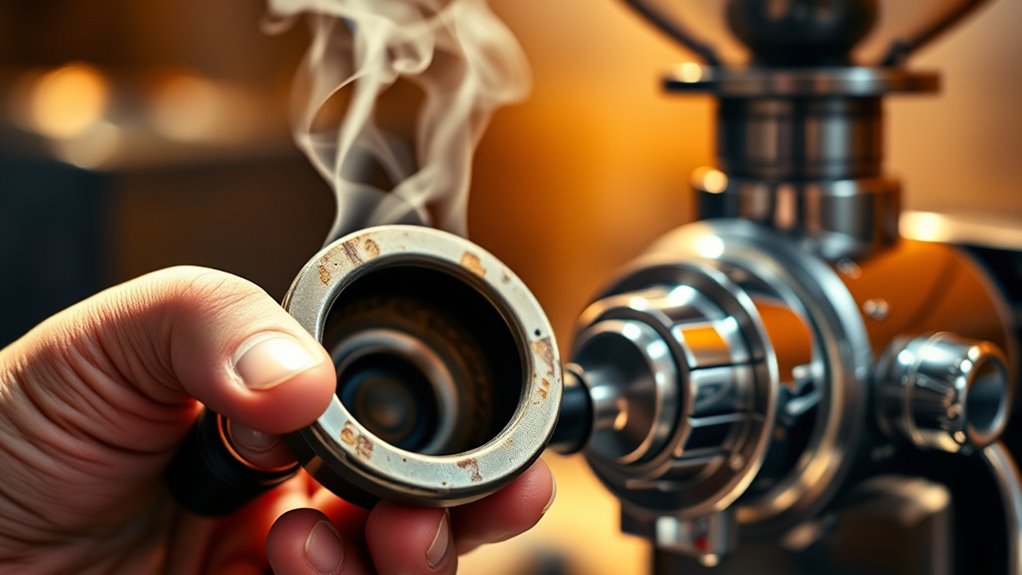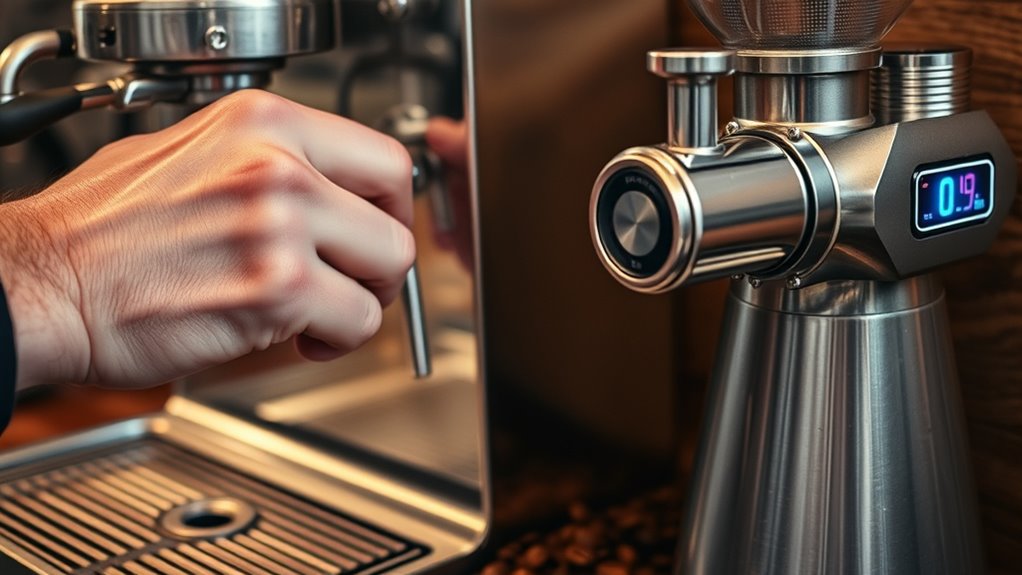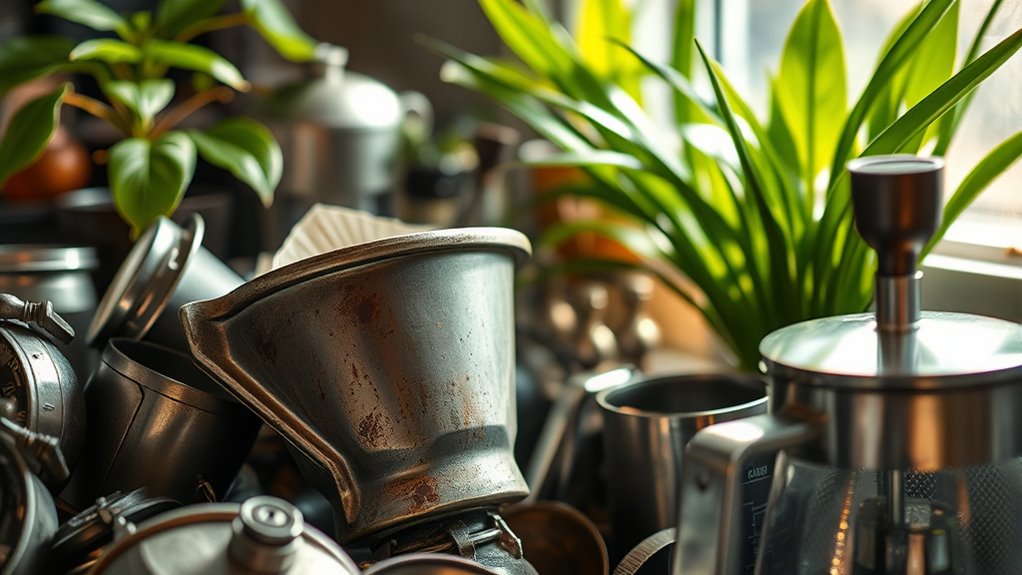If your coffee maker shows signs like inconsistent brewing, strange noises, leaks, or fluctuating temperatures, it’s time to contemplate an upgrade. Rising repair costs, declining taste quality, and increased energy use also signal that your machine may be aging out. Safety concerns and environmental impact are other factors to weigh. To make the best decision, you should assess these signs carefully; more details can help you determine if it’s time for a refresh.
Key Takeaways
- Consider replacing if repair costs exceed 50% of a new machine’s price or frequent breakdowns persist.
- Upgrade when equipment no longer maintains consistent brewing temperature or flavor quality.
- Replace outdated gear lacking modern features like smart integration and energy efficiency.
- Prioritize replacement if safety concerns like leaks, electrical faults, or material wear arise.
- Evaluate environmental impact; recycling and eco-friendly disposal support sustainability when upgrading.
Signs Your Coffee Maker Is Showing Its Age

Over time, your coffee maker can start showing signs of wear that indicate it may be nearing the end of its lifespan. One clear sign is inconsistent brewing temperature, which affects how well your coffee extracts. If your coffee tastes weak or overly bitter, your machine might not be heating properly. Additionally, if you notice fluctuations in flavor, it could be due to poor temperature regulation. Another sign is difficulty in maintaining your preferred coffee bean selection; if your machine no longer extracts the full flavor from your favorite beans, it may be losing efficiency. You might also see leaks, strange noises, or longer brewing times. These issues suggest it’s time to evaluate whether repairs are worth it or if replacing your coffee maker would deliver better coffee quality and reliability. Regular maintenance and tuning your equipment can help prolong its lifespan and ensure optimal performance. Furthermore, considering technological advancements in newer models can provide improved features and energy efficiency. Recognizing signs of aging early can help you decide whether to upgrade or stick with repairs for your coffee gear. Additionally, an aging machine may lack the modern safety features present in newer models, which can be important for both safety and performance. Staying informed about brand reputation and reviews can also assist in making a wise replacement decision.
Changes in Coffee Flavor and Quality

As your coffee maker ages, you may notice noticeable changes in the flavor and overall quality of your brew. These shifts often stem from reduced efficiency or buildup that impacts the coffee aroma and flavor consistency. Here are three signs to watch for:
- Your coffee’s aroma weakens or becomes less inviting.
- The flavor varies from cup to cup, losing its usual balance.
- You need to use more coffee grounds to achieve the same taste.
- Mechanical failures such as faulty heating elements or clogged components can also affect brewing quality.
Additionally, wear and deposits can affect brewing efficiency, making it harder to enjoy that fresh, aromatic cup you love. Over time, wear and deposits can compromise the brewing process, making it harder to enjoy that fresh, aromatic cup you love. Additionally, AI safety measures in coffee equipment design can help prevent some of these issues through smarter diagnostics and maintenance alerts. Implementing automation in business has led to innovations like smart coffee machines that monitor performance and notify users when maintenance is needed, thus ensuring consistent quality. Replacing your coffee gear could restore the quality you expect.
Increasing Maintenance and Repairs

When your coffee maker starts requiring frequent repairs or stubborn maintenance, it’s a clear sign that the machine is nearing the end of its lifespan. Increasing maintenance costs and higher repair frequency can quickly add up, overshadowing the expense of a new machine. If you find yourself spending more time fixing issues rather than enjoying your coffee, it’s a strong indicator that replacement is worth considering. Persistent problems, costly repairs, and ongoing maintenance can become a burden, signaling that your equipment is no longer reliable. Instead of pouring money into repairs that only offer temporary fixes, evaluate whether investing in a new coffee maker might save you time and money in the long run. When maintenance becomes a recurring hassle, it’s probably time for an upgrade. Regularly assessing the overall performance and durability of your coffee gear can help prevent unnecessary frustration and expenses. Additionally, considering the emotional support that a reliable coffee machine provides can enhance your daily routine and reduce stress. Furthermore, understanding the mechanics of arcade machines can help you make informed decisions about repairs and replacements.
Rising Energy Consumption and Inefficiency

If your coffee maker is consuming more energy than it used to, it’s a sign that its efficiency is declining. Over time, aging models tend to have higher power consumption, which impacts both your electricity bill and the environment. Think about these points:
- Decreased energy efficiency means your machine uses more power to brew the same cup.
- Increased power consumption can lead to higher utility costs each month.
- Older models may struggle to maintain ideal performance, wasting energy in the process. Regular maintenance and tuning upgrades can help optimize your coffee gear’s efficiency and extend its lifespan. Furthermore, energy-saving features incorporated into modern coffee makers can enhance overall efficiency.
- Using energy-efficient appliances can significantly reduce your overall energy use and costs.
Upgrading to a newer, energy-efficient coffee maker can save you money and reduce your carbon footprint. If your current gear shows signs of rising energy use, it’s probably time to think about a replacement.
Difficulty in Achieving Consistent Results

As your coffee gear wears out, it becomes harder to produce the same great taste every time. Wear and tear can cause inconsistent brew quality, frustrating your morning routine. Outdated technology may also limit your ability to achieve the desired finish for a perfect cup. Additionally, just as vintage gumball machines are valued by collectors, older coffee equipment might have sentimental or nostalgic appeal but could also lack the latest features that improve brewing consistency. Regular equipment maintenance can help prevent breakdowns and ensure your machine continues to perform at its best, maintaining optimal performance and flavor extraction, ensuring each cup meets your expectations.
Wear and Tear Effects
Over time, wear and tear on your coffee gear can lead to inconsistent brewing results. Cosmetic damage and aesthetic deterioration may seem minor, but they can impact performance. Here are three signs to watch for:
- Chipped or scratched surfaces – These affect the presentation and may harbor bacteria.
- Faded markings or labels – Makes it harder to follow precise measurements.
- Rust or corrosion – Compromises the integrity of metal parts, affecting flow and temperature control. Regular maintenance can help prevent some of these issues before they worsen. Additionally, understanding industry trends can inform you about the latest gear innovations that might improve your brewing quality. These issues don’t just impact looks; they can interfere with your gear’s functionality. If your machine’s appearance is deteriorating or key components are compromised, it’s time to contemplate replacing or repairing. Staying vigilant ensures consistent results and a better coffee experience.
Inconsistent Brew Quality
Inconsistent brew quality often signals that your coffee gear may be nearing the end of its ideal lifespan. If you’re struggling to get the same flavor and strength each time, it could be due to uneven brewing temperature or stale coffee beans. Over time, buildup inside your machine can affect water temperature, leading to under-extraction or over-extraction. Additionally, using old or improperly stored coffee beans can cause flavor variations, making it harder to achieve consistent results. Regularly cleaning your equipment and ensuring your beans are fresh can improve brew stability. If these adjustments don’t help, it might be time to contemplate replacing your coffee gear, as aging equipment often can’t maintain the precise temperature needed for consistent extraction.
Outdated Technology Limitations
Outdated technology in your coffee machine can considerably hinder your ability to produce consistent results. If your equipment lacks modern features, you might face issues like uneven brewing or temperature fluctuations. Upgrading can help you:
- Enable smart home integration, allowing remote control and customization for perfect brews.
- Achieve aesthetic redesign, giving your kitchen a sleek, modern look that matches your style.
- Access advanced brewing technology that ensures each cup is as good as the last.
Sticking with outdated gear can limit your control and consistency, making it harder to enjoy a perfect coffee every time. An upgrade not only improves function but also streamlines your routine and enhances your kitchen’s appearance.
Technological Advancements and New Features

New brewing technologies and smart features can transform your coffee experience, making it faster and more consistent. Upgrading lets you access innovative tools like precision temperature control and app connectivity, giving you more control over your brew. If you want a more efficient and customizable setup, it might be time to contemplate the latest models.
Innovative Brewing Technologies
Advancements in brewing technology are constantly transforming how you prepare your favorite coffee. Modern machines now emphasize maintaining coffee bean freshness and precise brewing temperature, elevating flavor extraction. Here are three innovations to consider:
- Smart Temperature Control: Precise brewing temperatures ensure maximum flavor without over-extraction, preserving coffee bean freshness.
- Grind Size Optimization: Automated grinders adjust grind size based on brewing method, enhancing consistency and flavor.
- Sealed Brew Chambers: Improved sealing keeps coffee fresh longer, preventing staleness and maintaining ideal coffee bean freshness.
These technologies deliver a better cup, but if your current gear lacks these features, it might be time to upgrade for a more flavorful, fresher brew.
Enhanced User Features
Modern coffee makers now come equipped with a range of user-friendly features that make brewing easier and more customizable. With intuitive controls and programmable settings, you can easily adjust brewing speed to suit your schedule, ensuring your coffee is ready exactly when you want it. Many models now include features that enhance the coffee aroma, such as advanced heating elements and aroma-enhancing brewing cycles. These upgrades allow you to fine-tune temperature and extraction, resulting in richer, more flavorful coffee. Additionally, smart connectivity lets you control your machine remotely, giving you the convenience of starting your brew from your phone. These technological advancements not only improve your overall coffee experience but also make your daily routine more efficient and enjoyable.
Cost Comparison: Repair vs. Replacement

Deciding whether to repair or replace your coffee gear often boils down to cost. To make an informed choice, perform a cost comparison by considering these factors:
Weigh repair costs against replacement expenses to determine the most economical choice for your coffee gear.
- Repair costs – Are repairs affordable, or do they add up quickly?
- Replacement expenses – Will buying a new machine be a one-time investment?
- Long-term savings – Does a new model save you money on energy or maintenance?
If repair costs approach or exceed half the price of a new unit, replacement might be smarter. Conversely, if repairs are minor and inexpensive, fixing your current gear could be more economical. Conducting a thorough repair vs. replacement cost comparison helps you decide if upgrading now saves money in the long run or if repairs will suffice.
Safety Concerns and Wear and Tear

As your coffee machine ages, safety concerns and wear and tear become increasingly important factors to contemplate. Over time, electric safety issues may arise due to frayed cords, damaged insulation, or faulty wiring, risking electric shocks or fires. Material degradation, such as cracks in the plastic or corrosion in internal components, can compromise the machine’s integrity. You might notice leaks, unusual noises, or inconsistent performance, indicating parts are breaking down. Ignoring these signs can lead to safety hazards or equipment failure. Regular inspections are essential to detect early damage. If you find significant wear, especially related to electrical components or structural integrity, replacing your coffee gear is the safest choice. Prioritizing safety ensures you enjoy your coffee routine without unnecessary risks.
Impact on Daily Routine and Convenience

When safety concerns and wear and tear start to impact your coffee machine, you may notice it becomes less dependable and more frustrating to use daily. This can disrupt your brewing ritual and diminish the coffee shop experience you enjoy at home. Consider these points:
- Longer wait times as your machine struggles to heat or brew properly
- Inconsistent coffee quality, making each cup feel less special
- Frequent repairs or maintenance, pulling you away from your routine
These issues can make your mornings less convenient, forcing you to adjust your schedule or settle for subpar coffee. If your gear no longer supports your preferred brewing ritual seamlessly, upgrading ensures you maintain a smooth, enjoyable routine and keep the coffee shop vibe alive every day.
Environmental Considerations and Sustainability

When choosing new coffee gear, consider options made from eco-friendly materials to reduce your environmental impact. Think about how you’ll recycle or dispose of your old equipment responsibly to minimize waste. Making sustainable choices helps protect the planet while you enjoy your daily brew.
Eco-Friendly Materials Choice
Choosing eco-friendly materials for your coffee gear allows you to enjoy your favorite brew while reducing your environmental impact. Opting for items made with sustainable design ensures you contribute to less waste and lower carbon footprints. Here are three ways to prioritize eco-friendly materials:
- Select coffee makers made from biodegradable or recycled plastics to minimize plastic waste.
- Choose stainless steel or glass mugs that are durable and easy to reuse, reducing single-use disposables.
- Look for equipment with certifications indicating the use of sustainable materials, supporting eco-friendly manufacturing practices.
Recycling and Disposal Options
Ever wondered what happens to your coffee gear after use? Recycling programs and proper disposal methods help minimize environmental impact. Many coffee machines and accessories are recyclable, but you need to check local programs to verify proper handling. For example, some components like plastic, metal, and electronic parts can be separated and recycled through designated centers. If your gear isn’t recyclable, consider eco-friendly disposal methods, such as taking it to a hazardous waste facility or donating it if it’s still functional. Proper disposal reduces landfill waste and prevents harmful materials from polluting the environment. Always research your local recycling options and follow recommended disposal methods to make a positive environmental difference with your coffee gear.
Frequently Asked Questions
How Long Should a Typical Coffee Maker Last?
A typical coffee maker lasts about 5 to 10 years, depending on usage and maintenance. To extend its life, follow maintenance tips like regular descaling and cleaning. Pay attention to the brand’s reputation for durability and support, which can influence longevity. If your machine starts to brew poorly or shows signs of wear despite proper care, it’s probably time to replace it. Proper maintenance and choosing reputable brands help maximize your coffee maker’s lifespan.
Are Newer Models Energy-Efficient Compared to Older Ones?
Newer coffee machine models often feature improved energy efficiency, helping you save on electricity and reduce environmental impact. They incorporate eco-friendly designs that minimize power consumption during standby and brewing modes. By upgrading, you benefit from better energy savings, making your coffee routine more sustainable. If your current machine is outdated, investing in a newer, energy-efficient model can be a smart choice for both your wallet and the planet.
What Safety Features Should I Look for in a Replacement?
When choosing a replacement coffee maker, look for safety certifications like UL or ETL, which guarantee the device meets safety standards. Overheating protection is essential to prevent accidents and damage. Check if the machine has automatic shut-off features and sturdy construction. These safety features help keep you safe during daily use, giving you peace of mind while enjoying your coffee. Prioritize these aspects for a secure and reliable upgrade.
Can Upgrading Improve Coffee Quality Significantly?
Upgrading your coffee gear can markedly improve coffee flavor and brewing consistency. Newer machines often feature advanced temperature control and precision brewing, allowing you to extract richer flavors and maintain consistent quality. If your current equipment is outdated or inconsistent, investing in an upgrade can elevate your coffee experience, ensuring each cup tastes better and more reliably. So, yes, upgrading can make a noticeable difference in your daily brew.
Is It Better to Repair or Replace for Environmental Reasons?
Think of your coffee gear as a friend needed to grow, not just replace. Repairing often symbolizes giving your equipment a second chance, reducing waste and keeping resources alive. Recycling benefits and eco-friendly materials make repairs more sustainable. When your gear can be fixed with eco-friendly parts, it’s better for the environment. You preserve the planet’s resources and lessen landfill waste, making repair a mindful, eco-conscious choice over replacement.
Conclusion
So, when your coffee maker starts acting like a diva—demanding constant repairs, ruining your brew, and sipping more energy than a small appliance—you might want to contemplate an upgrade. After all, who needs a machine that’s more trouble than it’s worth? Sometimes, tossing it out and starting fresh isn’t just about better coffee; it’s about reclaiming your mornings and saving the planet from your stubborn, aging gadget. Cheers to better brews ahead!









